IN THIS ISSUE
- Rare plants BOLO
- Terry's first black witch
- Debby vs. sea turtle nests
- Spotted skunk in Walker County
 Get drawn for a coveted DNR cap (longleaf pine cone not included)
Georgia Wild readers, we want to know what you think about this newsletter!
And all who provide that feedback through our reader survey – which takes only about seven minutes to complete – can put their name in the hat for a DNR cap.
But cap or not, you win. That’s because your comments will help improve Georgia Wild, meaning more of the wild news you like sent free to your inbox each month.
Click the button below, take the survey and, to join the drawing for one of 10 cool caps, add your email.
But do it soon. The survey closes Sept. 13. If you win a hat, we’ll let you know by Sept. 23.
 Flame flower in bloom (Pierre Howard)
By BRIANNA JAMISON
Georgia DNR could use your help here.
The plant commonly referred to as flame flower or hummingbird flower (Macranthera flammea) is a state-threatened, herbaceous species known from the southeastern Coastal Plain of the U.S. But DNR wants to know more about where flame flower is found in Georgia.
Think of it as a rare-plant scavenger hunt.
For details on what to look for, where, when and why, read this blog post. But as a quick overview:
Flame flower is the only species in its genus and looks like no other plant in the state. Flowering individuals can be 5-10 feet tall. The plant flowers from late August through September.
The species is found in Coastal Plain wetlands, typically along the margins, in the transition zone between pine uplands and seepage bogs, streamside thickets or cypress-gum ponds.
The suppression of fires in Coastal Plain pine savannas and the creation of firebreaks in wetland ecotones have threatened flame flower’s viability by increasing canopy cover and competition from other plants. The alteration of streams and wetlands has also reduced its habitat.
Flame flower is considered a high-priority species in Georgia’s State Wildlife Action Plan, a statewide strategy to conserve native wildlife before they become rarer and more costly to conserve or restore. Macranthera flammea is likely critically imperiled in the state, but more data is needed.
DNR is encouraging private landowners in the Coastal Plain to keep an eye out for flame flower. If spotted, please email photos of the plant, its flowers and notes or pictures about the immediate habitat to senior botanist Lisa Kruse.
The data will be used to help researchers better understand how flame flower is doing in Georgia and could prove critical to conserving and restoring the species.
One caution: Don’t remove flame flower or any of its parts. The species depends on relationships with neighboring plants and won’t survive outside of its habitat.
OTHER PLANT HUNTS
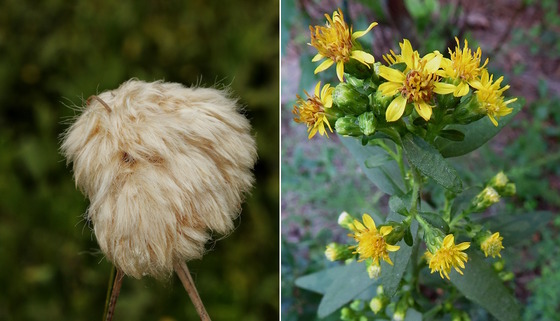 Tawny cottongrass (left), Porter's goldenrod (Alan Cressler/cottongrass; goldenrod/special to DNR)
The Georgia Plant Conservation Alliance is also asking that GPS locations and clear images of the following species be sent to gabiodata@dnr.ga.gov.
- Particularly in the Okefenokee Swamp, report tawny cottongrass (Eriophorum virginicum). Tip: From summer to fall, look for fluffy cottonball flowers growing on plants 1- to 4-feet tall in the Okefenokee (as well as in wet meadows on Fall Line sandhills).
- In Morgan County, do the same for Porter’s goldenrod (Solidago porteri). Tip: Watch for the plant’s bright yellow flowers and fuzzy leaves on the edges of woodland habitats from August into October.
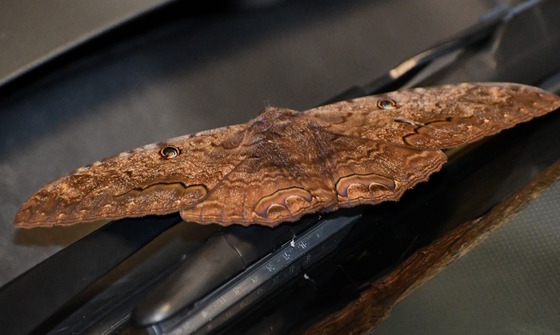 Black witch moth in Monroe County (Terry W. Johnson)
By TERRY W. JOHNSON
One of the rarest moths seen in Georgia is the black witch. Ascalapha odorata is so unusual that many folks who enjoy watching and photographing moths in the Peach State have never, or will ever, see one.
I had just about given up hope of catching a glimpse of a black witch until a few weeks ago when a friend called early one morning to ask if I wanted to see one trapped in his garage. I could hardly believe what he was saying!
I quickly dressed, grabbed my camera, jumped into the car and bee-lined it to his Monroe County home.
When I arrived, he ushered me into the garage and pointed to a very large moth resting on the windshield wipers of his car. My seemingly impossible quest to see a black witch was over.
Almost as remarkable, only days before a mutual friend had found one roosting under a shed roof near her home in neighboring Lamar County. She later spotted at least two more black witches.
There are three reasons why this moth is so special: It is extremely large, can travel long distances and is the subject of a host of legends. …
Read Terry’s column for more on these big, fascinating moths.
Terry W. Johnson is a retired DNR manager and executive director of TERN, friends group of the Wildlife Conservation Section. Check out past columns and his blog. Permission is required to reprint a column.
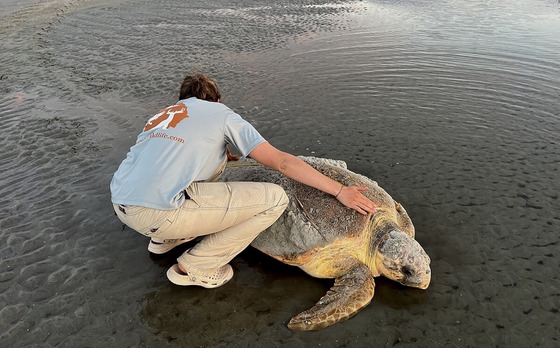 DNR sea turtle tech Emma Watson measures a dawn-nesting loggerhead on Ossabaw (Mark Dodd/DNR)
Debby's damage to sea turtle nesting in Georgia is still being assessed. While tidal surge and heavy rains from the tropical storm likely wiped out about 10 percent of the nests, at least half were inundated. Georgia Sea Turtle Cooperative members know which nests have been washed over and how many times this season, DNR Sea Turtle Program Coordinator Mark Dodd said. “What we don’t know is how the inundation (from Debby) will affect hatching success.” The eggs can survive some flooding. But nest inventories taken after any hatchlings have emerged will reveal the extent of loss, according to Dodd. He added that loggerheads, Georgia's primary sea turtle species, have evolved to survive impacts from extreme weather, with females laying multiple nests every two to four years. Hatching updates.
DNR’s work to help private landowners with wildlife and conservation is often overlooked but always vital. Two senior biologists recently met with an Upson County resident who manages 650 acres along the Flint River, land that overlooks spectacular shoals and connects to other family-owned tracts with granite outcrops and rare species. As part of the discussion, the landowner was pleasantly surprised to learn that a conservation easement could help permanently protect her property while also allowing timber sales and hunting leases to generate income.
 A Georgia solar farm in the early stages of construction (Rick Lavender/DNR)
As more solar farms take root in Georgia, guides created by DNR and partners are helping ensure that proposed locations and facility designs take into account the potential impacts on wildlife, such as habitat loss and fragmentation. The guides include recommended practices and a “low-impact siting tool.”
Did you see this? An addendum to a 2022 survey of fishing, hunting and wildlife-related recreation in the U.S. estimates that the 148 million people who took part in wildlife viewing that year spent $250 billion on everything from plane tickets and lodging to binoculars and bird seed.
 Red-cockaded woodpecker and a southern flying squirrel (Josiah Lavender/DNR, Todd Schneider/DNR)
Quick hits:
- Southern flying squirrels sampled from red-cockaded woodpecker nest cavities in Mississippi and Alabama were rarely, if ever, eating the birds or their eggs, according to a study aimed at understanding how the small mammals – possibly North America’s most carnivorous squirrel and a competitor for tree cavities – interact with the endangered woodpeckers.
- National Hunting and Fishing Day on Sept. 28 not only offers free fishing in Georgia (residents do not need a fishing or trout license to fish public waters that day), it features more than 10 celebratory events statewide.
- More dates to remember: Dove season starts statewide Sept. 7 and the annual Becoming an Outdoors Woman workshop at Charlie Elliott Wildlife Center near Mansfield is Nov. 1-3 (register).
- Initial results from a gopher tortoise survey at Altama Plantation show that prescribed burns and timber harvests since 2016 – when tortoises were first surveyed at the Glynn County wildlife management area – are working, with numerous juvenile and sub-adult tortoise found in stands that were overgrown with shrubs and small hardwoods eight years ago.
- Southwest Georgia landowners battling feral hogs can sign up for training Oct. 29 to take part in the Georgia Feral Hog Task Force's trap rental program.
 Bob Rolader, Bobwhite Quail Initiative Wildlife Steward of 2024 (special to DNR)
Names in the news: Emanuel County’s Bob Rolader is the DNR Bobwhite Quail Initiative Wildlife Steward of the Year. Rolader has worked with the program for five years to improve his property for wildlife and has helped with outreach since 2020, including hosting Bobwhite Quail Initiative youth hunts and a landowner field day. DNR Game Warden Cory Bohannon, assigned to Lincoln County, has been named both the agency’s Game Warden and Boating Safety Officer of the Year. Game Warden 1st Class Jared Wood of Fannin County received the James R. Darnell Award and Cpl. Eric White of Colquitt County was named Investigative Game Warden of the Year (more award news). Erin Cork, a senior wildlife biologist with DNR’s Wildlife Conservation Section, teamed with José Garrido of the Amphibian and Reptile Conservancy to write an article on head-starting efforts to restore frosted flatwoods salamanders at Fort Stewart-Hunter Army Airfield, which has the Atlantic Coastal Plain's last known population of the threatened amphibians.
WHAT YOU MISSED ...
In the previous Georgia Wild:
- “Longleaf Forever” premieres
- Tortoise in the surf: What's up?
- In search of giant swallowtails
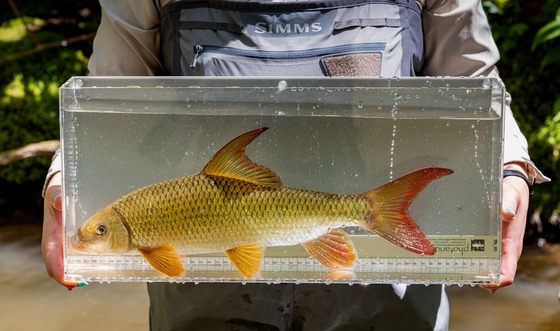 DNR staff with a sicklefin redhorse (Hill Henry/TVA)
(+video) "Sicklefin redhorse swims toward success," TVA
"Rare firefly identified in State Botanical Garden," UGA
(+audio) "In Macon, volunteers fight escaped garden plants to save endangered native," Georgia Public Broadcasting
"Current, former Dalton State students work to save trispot darter," Dalton Daily Citizen
"Plight of the bumblebee is cause for concern," The Atlanta Journal-Constitution
"Experts study mystery irises at Coastal Georgia Botanical Gardens," UGA
"Uncertain waters (Okefenokee National Wildlife Refuge)," The Nature Conservancy
"Feds announce funding push for ropeless fishing gear that spares rare whales," The Associated Press. Related: "The long road to ropeless fishing," Hakai Magazine.
"Scientists develop unique approach to conserve monarchs," USDA
"Study reveals mechanism used by tegus to raise own temperature," EurekAlert!(study in Acta Physiologica)
 Cottonmouth in "Magnificent Beings" documentary
"Magnificent Beings," Rob Tiffin
"The Prairie Preacher: Preserving Appalachia’s Grasslands," PBS
"Chip Madren with Outdoors Beyond Barriers," DNR
Coyote with mate near radio station, Wildlife Atlanta and UGA Warnell School of Forestry and Natural Resources. Related: "Coyotes are everywhere; should you be concerned?" UGA.
Saving rat snake that ate a golf ball, UGA Savannah River Ecology Lab
"How Does an Aquifer Work?" The Current
"Now Presenting ... Turtle Time with Luke," UGA Warnell School of Forestry and Natural Resources
Wolf cubs in Colorado, Colorado Parks and Wildlife Commission via resident
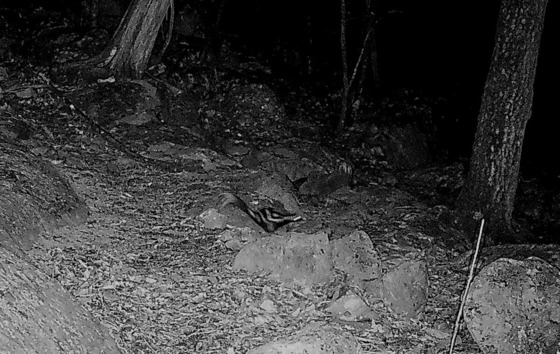 See the brushy-tailed critter in the center of this game camera image? That's an eastern spotted skunk. The image taken July 29 marks the first documented sighting of a spotted skunk in Walker County. But DNR Program Manager Katrina Morris is convinced there are more in northwest Georgia, and even across the state. Once common in the eastern U.S., eastern spotted skunks – unlike their larger cousin, the striped skunk – have become rare. Why is unclear. However, with sightings typically increasing as the weather cools and more game cams in use as deer season nears, Morris is encouraging Georgians to report spotted skunk sightings. Upload images and details to the Eastern Spotted Skunk project or email them to her (include latitude/longitude coordinates, data usually tagged in smartphone photos). Whether from live shots, road-kills or incidental captures by trappers, the reports will help researchers better understand the distribution and status of this secretive skunk. Learn more.
CREDITS
Masthead: flame flower (Alan Cressler)
Eastern spotted skunk (Austin Bradford/special to DNR)
Top
|